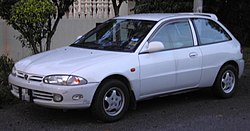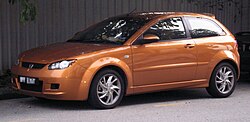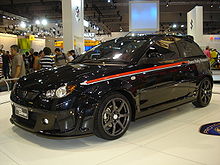Proton Satria
| Proton Satria / 300 | |
|---|---|
| Production period: | 1993-2015 |
| Class : | Small car |
| Body versions : | Station wagon |
The Proton Satria (also Proton 300 and Proton Compact ) was a hatchback sedan that the Malaysian car manufacturer Proton built from 1993 to 2005. The successor, internally called the Satria Replacement Model , was introduced as the Proton Satria Neo on June 16, 2006. The name “Satria” means “knight” in Bahasa Malaysia as a loan word from Sanskrit and should indicate the sportiness of the three-door car.
Satria / 300 (1993-2005)
| Satria / 300 | |
|---|---|
|
Proton Satria (1993-1996) |
|
| Production period: | 1993-2005 |
| Body versions : | Station wagon |
| Engines: |
Gasoline engines : 1.3-1.6 liters |
| Length: | 3995 mm |
| Width: | 1710 mm |
| Height: | 1365 mm |
| Wheelbase : | 2440 mm |
| Empty weight : | 1005 kg |
The first generation of the Satria was a three-door hatchback sedan based on the 1991 Mitsubishi Mirage . The changes were limited to the design of the front of the vehicle and the fact that the interior fittings were taken over from the larger Wira / 400 . The drive was the Orion 4G13p and 4G15p engines with 12 valves from Mitsubishi , four-cylinder in-line engines with displacements of 1.3 or 1.5 l. There was also the 4G9 engine from the same manufacturer, also a four-cylinder, but with an overhead camshaft , 16 valves and 1.6 l displacement. While the 1.3 l was only available with a manual five-speed gearbox, the 1.5-liter and 1.6-liter 16V were also available with a three- or four-speed automatic gearbox on request.
The equipment levels were called LSi, GLi, GLSi and SEi. The LSi equipment was only available in conjunction with the 1.3 l engine. The GLi was available with a 1.3- or 1.5-liter engine, while the two higher equipment variants were available with either a 1.5-liter or a 1.6-liter 16V engine.
In 1996, a revised version was presented in Malaysia , which was later available in other countries and whose rear view was different from that of the Mitsubishi Mirage. There were the new equipment variants XLi, S XLi and GTi. There were also new engines with 1.3 l, 1.5 l and 1.6 l 16V.
Satria GTi
The Satria Sports GTi had a 1.8 l four-cylinder in-line engine from Mitsubishi, which developed 138 hp (102 kW) and was also installed in the Mitsubishi Lancer GSR, but without a turbocharger and with increased compression.
This model was later further developed by Lotus Engineering, with the engine being modified so that it now delivered 141 hp (104 kW). The top speed was 204 km / h.
Lotus also used an aerodynamically improved body. In Great Britain this special model had a Lotus emblem under the type designation Proton Satria GTi. Proton claims the Satria GTi is the fastest car they have ever built.
The MMC (Mitsubishi Motor Company) version was built from the beginning in 1999 to 2002. The VDO (Siemens) version, which is said to have had slightly less power and minor problems with the cold start, was built between 2002 and 2005 when Proton stopped production.
Satria R3
The Proton Satria R3 was a special model of the Satria that was only offered in Malaysia. The designation R3 stands for Race, Rallye, Research . The R3 was a Satria GTi that had been redesigned by Proton's racing department and Lotus. He also had the 4G93p engine from Mitsubishi with 1.8 l displacement, which was, however, slightly improved by Lotus. The structure has been upgraded with a double-welded monocoque chassis with stabilizers at the front and rear.
Satria Neo (2006-2015)
| Satria Neo | |
|---|---|
|
Proton Satria Neo (2006-2015) |
|
| Production period: | 2006-2015 |
| Body versions : | Station wagon |
| Engines: |
Petrol engines : 1.3-1.6 liters (69-107 kW) |
| Length: | 3898-3905 mm |
| Width: | 1710-1745 mm |
| Height: | 1420-1434 mm |
| Wheelbase : | 2440 mm |
| Empty weight : | 1146-1227 kg |
The Satria Neo was introduced in June 2006 as the successor to the first Satria and is an independent compact class model with transverse engine and front-wheel drive developed with Lotus. It stands on a new platform developed by Proton itself, which borrowed from the larger Gen-2 and Waja models . At the moment the car is only available as a three-door hatchback. The development cost 500 million RM and took four years. It should secure Proton monthly sales of 2,000 to 2,500 vehicles. The car is said to be “young and sporty” and was presented by former Malaysian Prime Minister Abdullah Ahmad Badawi .
The basic engine is a four-cylinder in-line engine with two overhead camshafts with a displacement of 1.3 l, an output of 94 hp (69 kW) at 6000 min −1 and a torque of 120 Nm at 4000 min −1 . The model M and the top model H equally be driven by a 1.6 liter version of the same motor, 110 horsepower (81 kW) at 6000 min -1 making and a torque of 148 Nm at 4000 min -1 developed. Both models have radios with an RDS system. In addition to the standard, manual five-speed gearbox, all models have four-speed automatic gearboxes from Mitsubishi that have been carried over from the previous model. The H model has safety equipment such as two airbags , ABS , EBD and belt tensioners . All models have a built-in Blaupunkt CD player.
The low head and legroom for the rear seat passengers (also compared to the previous model) and the rather modest performance compared to the Satria GTi are criticized. The well-known weak torque of the Campro motor from Proton is also clearly noticeable.
MEM Proton Satria Neo Super 2000 Rally Car
Mellors Elliot Motorsport (MEM) built a Super 2000 racing car based on the Proton Satria Neo. The car is powered by the Waja's 1.8 liter engine.
Proton Satria Neo CPS
In February 2009 Proton released the CPS version of the Satria Neo, which replaced the top-of-the-line H. It has aggressive looking tuning parts and spoilers that are reminiscent of the Satria GTi. The car is powered by the 1.6 l Campro CPS engine, which delivers 125 hp (92 kW) and 150 Nm of torque, and has been proven not to suffer from the weak torque of the old Campro engines. Compared to the Waja, Gen-2 and Exora models, the valve train has been modified to support a more aggressive driving style.
Proton Satria Neo R3 Lotus Racing
With the presentation of the Satria Neo R3 Lotus Racing special model limited to 25 copies on March 30, 2010, Proton somehow frightened the public. The RM115k has several improvements compared to the Satria Neo CPS. From the outside it is not that different, but its equipment is comprehensive. The engine is tuned like the first R3 and has a special engine control, R3 camshafts with adjustable aluminum cams and a special exhaust system. The R3 inlet is made of CFRP and has a K&N air filter. The drive ratios have been changed so that they harmonize with the higher engine output. This motor therefore performs approx. 13.8% more than the normal Campro CPS. The engine output is now 145 HP (107 kW) and the torque 168 Nm. The top speed of the car is 205 km / h and the acceleration from 0 to 100 km / h is 9.2 seconds.
In addition to the engine improvements, the chassis and the handling have been through the use of Ohlins - struts improved. Bridgestone adrenaline tires sit on the 16 ″ rims from Advanti . Four-piston brakes from AP Racing complete the picture.
The interior remained almost unchanged, but the dashboard is now a greenish color to match the green Lotus emblem. There is a start button and green nappa leather. The pedals and switch are made of aluminum.
Technical specifications
| Neo R3 | |
|---|---|
| Engine characteristics | |
| Engine type | R4 petrol engine |
| Displacement | 1597 cc |
| Max. Power at min −1 | 93 kW (125 PS) / 6500 |
| Max. Torque in min -1 | 150 Nm / 4500 |
| Power transmission | |
| drive | Front wheel drive |
| Gearbox, as standard | Manual transmission |
| Gearbox, optional | ( Automatic transmission ) |
| Readings | |
| Length × width × height | 3898 mm × 1745 mm × 1434 mm |
| Top speed | 190 km / h (185 km / h) |
| Acceleration, 0-100 km / h | 10.5 s (12.9 s) |
| Fuel consumption over 100 km (combined) | |
| Tank capacity | 55 l |





